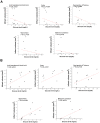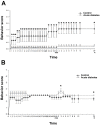The Influence of Acute Hyperglycemia in an Animal Model of Lacunar Stroke That Is Induced by Artificial Particle Embolization
- PMID: 27226775
- PMCID: PMC4879767
- DOI: 10.7150/ijms.14393
The Influence of Acute Hyperglycemia in an Animal Model of Lacunar Stroke That Is Induced by Artificial Particle Embolization
Abstract
Animal and clinical studies have revealed that hyperglycemia during ischemic stroke increases the stroke's severity and the infarct size in clinical and animal studies. However, no conclusive evidence demonstrates that acute hyperglycemia worsens post-stroke outcomes and increases infarct size in lacunar stroke. In this study, we developed a rat model of lacunar stroke that was induced via the injection of artificial embolic particles during full consciousness. We then used this model to compare the acute influence of hyperglycemia in lacunar stroke and diffuse infarction, by evaluating neurologic behavior and the rate, size, and location of the infarction. The time course of the neurologic deficits was clearly recorded from immediately after induction to 24 h post-stroke in both types of stroke. We found that acute hyperglycemia aggravated the neurologic deficit in diffuse infarction at 24 h after stroke, and also aggravated the cerebral infarct. Furthermore, the infarct volumes of the basal ganglion, thalamus, hippocampus, and cerebellum but not the cortex were positively correlated with serum glucose levels. In contrast, acute hyperglycemia reduced the infarct volume and neurologic symptoms in lacunar stroke within 4 min after stroke induction, and this effect persisted for up to 24 h post-stroke. In conclusion, acute hyperglycemia aggravated the neurologic outcomes in diffuse infarction, although it significantly reduced the size of the cerebral infarct and improved the neurologic deficits in lacunar stroke.
Keywords: animal model; embolization; hyperglycemia; lacunar stroke; microsphere.
Conflict of interest statement
Competing Interests: The authors have declared that no competing interest exists.
Figures






Similar articles
-
Characterization of the pattern of ischemic stroke induced by artificial particle embolization in the rat brain.Biomaterials. 2011 Sep;32(27):6381-8. doi: 10.1016/j.biomaterials.2011.05.051. Epub 2011 Jun 12. Biomaterials. 2011. PMID: 21665272
-
Variation in risk factors for recent small subcortical infarcts with infarct size, shape, and location.Stroke. 2013 Nov;44(11):3000-6. doi: 10.1161/STROKEAHA.113.002227. Epub 2013 Sep 5. Stroke. 2013. PMID: 24008573 Free PMC article.
-
Acute hyperglycemia worsens ischemic stroke-induced brain damage via high mobility group box-1 in rats.Brain Res. 2013 Oct 16;1535:148-55. doi: 10.1016/j.brainres.2013.08.057. Epub 2013 Sep 5. Brain Res. 2013. PMID: 24012767
-
[Lacunar cerebral infarct: its etiology, pathogenesis, clinical picture and treatment].Lik Sprava. 1998 Jul-Aug;(5):6-11. Lik Sprava. 1998. PMID: 9793296 Review. Ukrainian.
-
[Hyperglycemia: a predictor of poor prognosis in acute stroke].Diabetes Metab. 2001 Dec;27(6):718-20. Diabetes Metab. 2001. PMID: 11852383 Review. French.
Cited by
-
Diabetes and Alzheimer's Disease: A Link not as Simple as it Seems.Neurochem Res. 2019 Jun;44(6):1271-1278. doi: 10.1007/s11064-018-2690-9. Epub 2018 Dec 6. Neurochem Res. 2019. PMID: 30523576 Review.
-
Blood-Brain Barrier Disruption, Vascular Impairment, and Ischemia/Reperfusion Damage in Diabetic Stroke.J Am Heart Assoc. 2017 Jun 1;6(6):e005819. doi: 10.1161/JAHA.117.005819. J Am Heart Assoc. 2017. PMID: 28572280 Free PMC article. Review. No abstract available.
-
Establishment and Evaluation of a Monkey Acute Cerebral Ischemia Model.Clinics (Sao Paulo). 2020 Feb 27;75:e1339. doi: 10.6061/clinics/2020/e1339. eCollection 2020. Clinics (Sao Paulo). 2020. PMID: 32130353 Free PMC article.
-
Inhibition of mTOR signaling Confers Protection against Cerebral Ischemic Injury in Acute Hyperglycemic Rats.Int J Biol Sci. 2017 Jul 7;13(7):878-887. doi: 10.7150/ijbs.18976. eCollection 2017. Int J Biol Sci. 2017. PMID: 28808420 Free PMC article.
-
Development and Validation of Sorafenib-eluting Microspheres to Enhance Therapeutic Efficacy of Transcatheter Arterial Chemoembolization in a Rat Model of Hepatocellular Carcinoma.Radiol Imaging Cancer. 2021 Jan 8;3(1):e200006. doi: 10.1148/rycan.2021200006. eCollection 2021 Jan. Radiol Imaging Cancer. 2021. PMID: 33575658 Free PMC article.
References
-
- Norrving B. Long-term prognosis after lacunar infarction. The Lancet Neurology. 2003;2:238–45. - PubMed
-
- Bogousslavsky J. The plurality of subcortical infarction. Stroke; a journal of cerebral circulation. 1992;23:629–31. - PubMed
-
- Halkes PH, Kappelle LJ, van Gijn J, van Wijk I, Koudstaal PJ, Algra A. Large subcortical infarcts: clinical features, risk factors, and long-term prognosis compared with cortical and small deep infarcts. Stroke; a journal of cerebral circulation. 2006;37:1828–32. - PubMed
-
- Kostulas N, Markaki I, Cansu H, Masterman T, Kostulas V. Hyperglycaemia in acute ischaemic stroke is associated with an increased 5-year mortality. Age and ageing. 2009;38:590–4. - PubMed
-
- Sappok T, Faulstich A, Stuckert E, Kruck H, Marx P, Koennecke HC. Compliance with secondary prevention of ischemic stroke: a prospective evaluation. Stroke; a journal of cerebral circulation. 2001;32:1884–9. - PubMed
MeSH terms
Substances
LinkOut - more resources
Full Text Sources
Other Literature Sources
Medical

